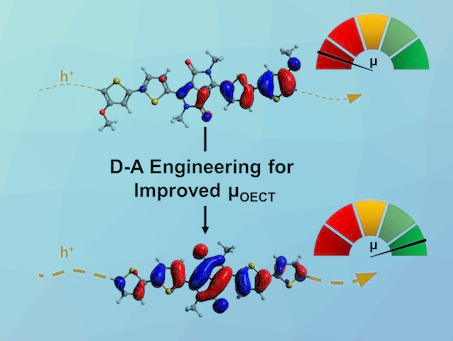Organic electrochemical transistors (OECTs) are electronic devices that can convert biological stimuli (e.g, ion fluxes) into electrical signals. This makes them useful for monitoring metabolic processes in living systems. OECTs consist of a semiconductor or conductor thin-film, called “channel” and usually made of a conjugated polymer, which is in direct contact with an electrolyte.
Ethylene glycol (EG)-functionalized organic semiconductors are promising channel materials. Currently, the highest performing EG-functionalized semiconductors for OECT applications are based on all‐donor backbones. However, donor–acceptor polymer backbones could minimize side‐reactions and improve the safety and performance of OECTs.
Maximilian Moser, University of Oxford, UK, Iain McCulloch, University of Oxford and King Abdullah University of Science and Technology (KAUST), Thuwal, Saudi Arabia, and colleagues have synthesized three EG-functionalized donor-acceptor conjugated polymers based on diketopyrrolopyrrole (DPP) that provide OECT performances similar to those of all‐donor polymers. The team synthesized thiophene-flanked DPP units via a condensation reaction between diethyl succinate and 2‐thiophenecarbonitrile. The DPP unit was then functionalized with triethylene glycol chains and brominated to give a DPP-based monomer. This monomer was used in Stille cross‐coupling polymerizations with either 2,5-bis(trimethylstannyl)thieno[3,2-b]thiophene, 5,5’-bis(trimethylstannyl)-2,2’-bithiophene, or (3,3′-dimethoxy-[2,2′-bithiophene]-5,5′-diyl)bis(trimethylstannane) to give the three different polymers.
All three polymers provide good OECT performance. The team found that increasing the degree of polaron delocalization in these semiconductors is important for improving their performance. Polarons are quasiparticles used in condensed matter physics to understand the interactions between electrons and atoms, e.g, in organic semiconductors or organic solar cells. This work provides guidelines for future OECT material design.
- Polaron Delocalization in Donor‐Acceptor Polymers and its Impact on Organic Electrochemical Transistor Performance,
Maximilian Moser, Achilleas Savva, Karl Thorley, Bryan D. Paulsen, Tania Cecilia Hidalgo, David Ohayon, Hu Chen, Alexander Giovannitti, Adam Marks, Nicola Gasparini, Andrew Wadsworth, Jonathan Rivnay, Sahika Inal, Iain McCulloch,
Angew. Chem. Int. Ed. 2020.
https://doi.org/10.1002/anie.202014078




